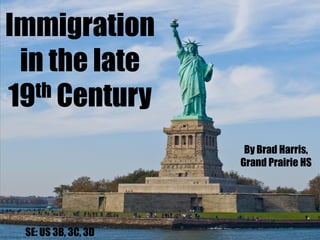
Unit 1 powerpoint #4 (the gilded age immigration)
- 1. Immigration in the late 19 th Century By Brad Harris, Grand Prairie HS SE: US 3B, 3C, 3D
- 2. “Old Immigration” When the 13 colonies were Ireland England established, most immigrants coming to France America were from England. Between 1840-1850, 1.5 million immigrants came to America. Nearly ½ were from Ireland due to a potato famine. Most settled in New York City or Boston.
- 3. “New Immigration” By 1920, most immigrants coming to the United States Russia were from Southern Poland Hungary and Eastern Europe Most immigrants Italy came from Italy or Greece were Slavic, and many were Jews
- 6. A Land of Hope The Statue of Liberty in New York Harbor was the symbol of America to many immigrants looking for a new life “Give me your tired, your poor, your huddled masses yearning to breathe free, the wretched refuse of your teaming shore. Send these, the homeless, the tempest-tost to me, I lift my lamp beside the golden door.” -- Statue of Liberty
- 7. Ellis Island Immigrants coming into New York were stopped at Ellis Island Incoming immigrants were given a physical to check for diseases and their criminal record was checked
- 9. Ethnic Cities – Little Italy Little Italy, New York City, circa 1901 By 1900, immigrants made up a great portion of the country’s largest cities, including New York City, Chicago and Boston
- 10. Ethnic Cities - Chinatown Chinatown, New York City Immigrants lived in their own separate neighborhoods – like Little Italy or Chinatown – and kept many of their former traditions.
- 12. Tenement dwellings Immigration led to a massive increase in the number of slums in U.S. cities.
- 13. Tenement dwellings Tenements – cheaply built apartment buildings – were often overcrowded and lacked many necessities.
- 14. Tenement dwellings Cities could not keep up with the massive rise in population, leading to poor city services.
- 22. The Rise of Nativism The flood of immigrants into the U.S. worried many Americans who felt their way of life could be changed. Nativism is an extreme dislike for foreigners by native-born people and a desire to limit immigration.
- 23. The Rise of Nativism Workers blamed immigrants for low wages or shortages of employment. A resentment of foreigners crept into America’s attitudes. New immigrants were blamed for many of the nation’s problems that were brought on by the Industrial Revolution
- 25. Asian Immigration During the late 1800s, the west coast (California) saw a boom in the amount of immigrants coming from Asia. Most Chinese immigrants came to America because over- crowding in China; many Chinese settled in Los Angeles and in San Francisco
- 26. Chinese Exclusion Act The Chinese Exclusion Act was the law passed by Congress in 1882 that greatly reduced the amount of Asian immigrants coming to America
- 27. Chinese Exclusion Act The law barred Chinese immigration for 10 years and prevented the Chinese from becoming U.S. citizens.
- 29. Summary • Beginning in the late 1800s, most immigrants coming to the U.S. were from southern and eastern Europe • Immigrants lived in their own separate neighborhoods and kept many of their former traditions. • Immigration led to a massive increase in the number of slums and tenement buildings in U.S. cities. • Workers blamed immigrants for low wages or shortages of employment. A resentment of foreigners crept into America’s attitudes.
- 30. Coming up next… Child Labor during the Gilded Age